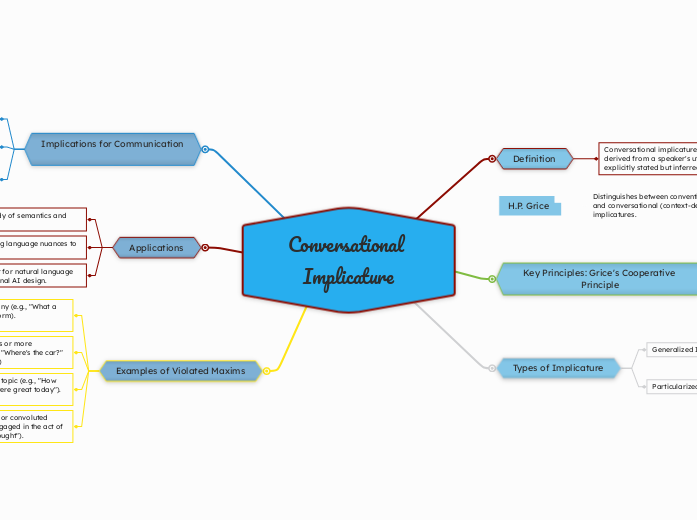作者:Kath Ibarra 11 月以前
145
Conversational Implicature

Conversational Implicature
Examples of Violated Maxims
Flouting Manner: Using obscure or convoluted expressions (e.g., "The entity engaged in the act of purchasing" instead of "They bought").
Flouting Relation: Changing the topic (e.g., "How was work?" Answer: "The kids were great today").
Flouting Quantity: Providing less or more information than required (e.g., "Where's the car?" Answer: "In front of a building")
Flouting Quality: Sarcasm or irony (e.g., "What a beautiful day!" said during a storm).
Applications
AI Development: Important for natural language processing and conversational AI design.
Teaching: Useful for teaching language nuances to learners.
Linguistics: Enhances the study of semantics and pragmatics.
Implications for Communication
Understanding implicature is crucial for interpreting indirect or implied meanings in interactions.
Helps achieve subtlety, humor, or politeness in communication.
Conversational implicature relies on shared knowledge and context.
Types of Implicature
Particularized Implicature
Requires specific context to infer meaning (e.g., "Can you pass the salt?" implies a request rather than a question about ability).
Generalized Implicature
Does not depend on specific context (e.g., "Some people passed the test" implies not everyone passed).
Key Principles: Grice's Cooperative Principle
Maxim of Manner
Be clear, avoid ambiguity, and be orderly.
Maxim of Relation
Be relevant.
Maxim of Quantity
Provide the right amount of information—neither too much nor too little.
Maxim of Quality
Be truthful. Do not provide information that is false or unsupported by evidence.
H.P. Grice
Distinguishes between conventional (immutable) and conversational (context-dependent) implicatures.
Definition
Conversational implicature refers to the meaning derived from a speaker's utterance that is not explicitly stated but inferred based on context.

